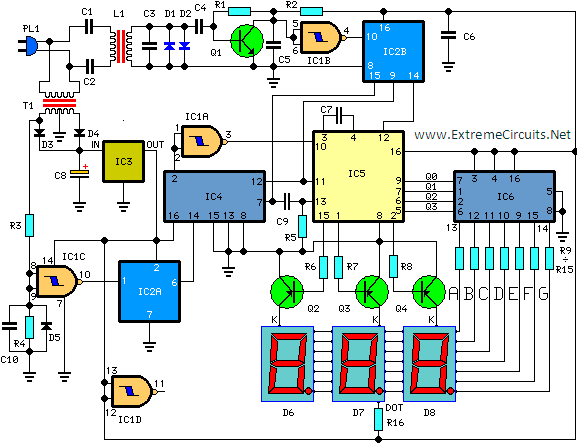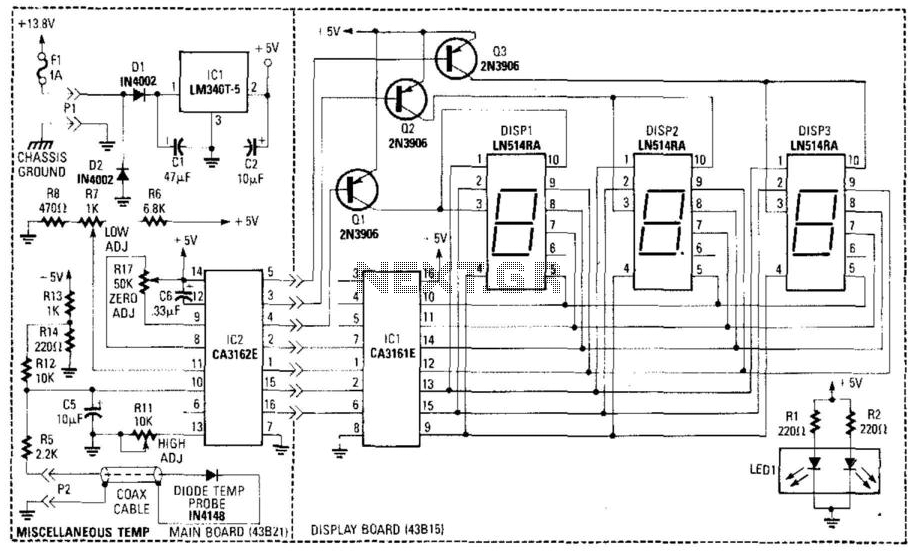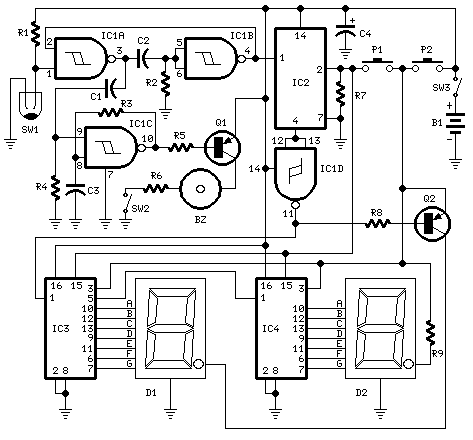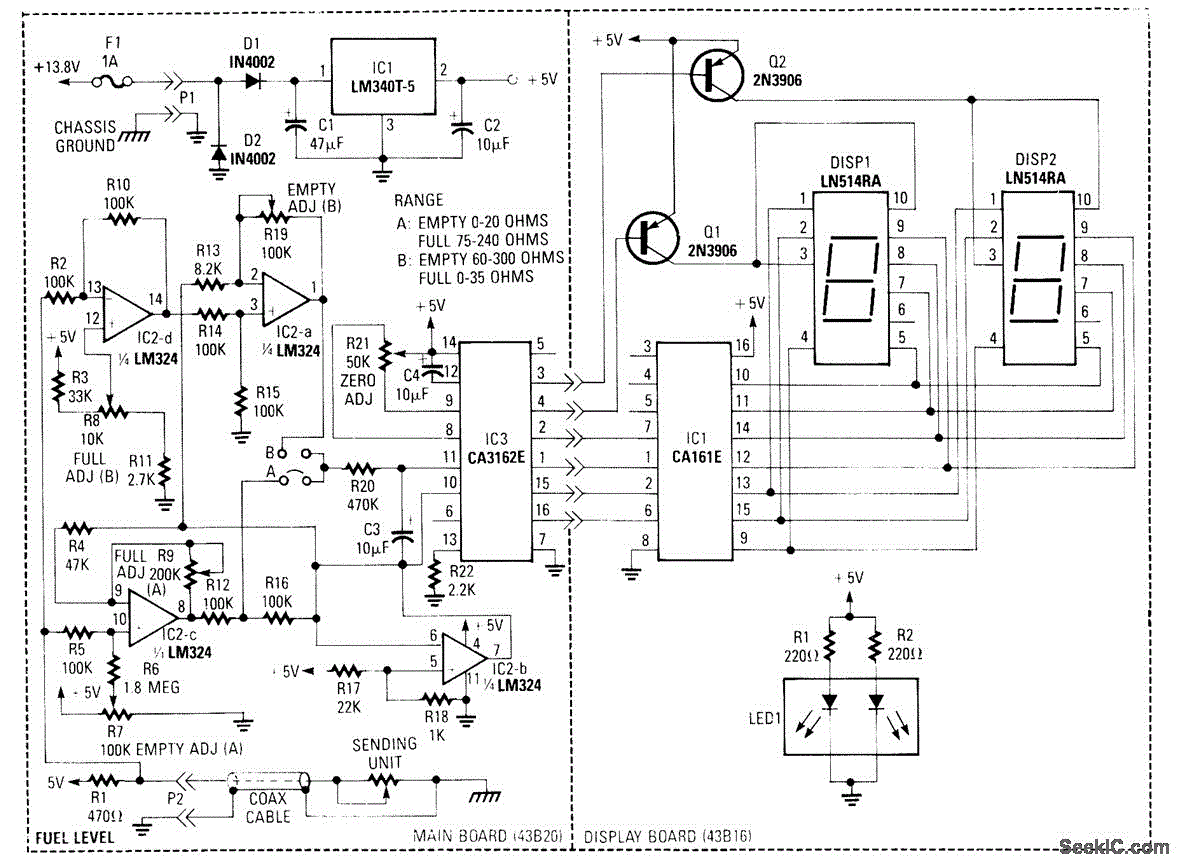
digital remote thermometer

This circuit is designed for precise measurement of temperature in degrees Celsius. It includes a transmitter section that converts the output voltage from the sensor, which is proportional to the temperature being measured, into a frequency signal. This frequency signal is transmitted through the mains supply cables. The receiver section counts the frequency bursts received from the mains supply and displays the count on three 7-segment LED displays. The least significant digit represents tenths of a degree, allowing for a temperature measurement range from 00.0 to 99.9 °C. The transmitter and receiver can operate at distances of up to one hundred meters, provided that both units are connected to the mains supply and are within the control of the same light meter.
The circuit operates by utilizing a temperature sensor that generates a voltage output related to the ambient temperature. This output is fed into an analog-to-frequency converter within the transmitter section. The converter processes the voltage signal and generates a frequency output that is directly proportional to the temperature. This frequency modulated signal is then superimposed on the mains supply lines, allowing it to be transmitted over long distances without the need for additional communication lines.
At the receiving end, the circuit incorporates a frequency counter that monitors the bursts of frequency signals arriving from the mains supply. The counter is calibrated to decode the frequency back into a temperature reading. The decoded information is then displayed on three 7-segment LED displays, with the first two displays representing whole degrees and the last display representing tenths of a degree. This configuration allows for a clear and precise visual representation of the temperature.
The design ensures effective operation over distances of up to one hundred meters, which is particularly advantageous in large buildings or industrial environments where direct wiring between the sensor and display may not be feasible. The use of the mains supply for signal transmission minimizes the need for additional wiring and simplifies installation.
Power supply considerations are also crucial in this design. Both the transmitter and receiver sections are powered from the mains supply, ensuring that they remain operational without the need for batteries or external power sources. The circuit's sensitivity and accuracy can be further enhanced by utilizing high-quality components and proper calibration methods during installation. This temperature measurement system is ideal for applications requiring reliable and accurate temperature monitoring in a variety of environments.This circuit is intended for precision centigrade temperature measurement, with a transmitter section converting to frequency the sensor`s output voltage, which is proportional to the measured temperature. The output frequency bursts are conveyed into the mains supply cables. The receiver section counts the bursts coming from mains supply and shows the counting on three 7-segment LED displays.
The least significant digit displays tenths of degree and then a 00.0 to 99.9 °C range is obtained. Transmitter-receiver distance can reach hundred meters, provided both units are connected to the mains supply within the control of the same light-meter.. 🔗 External reference
The circuit operates by utilizing a temperature sensor that generates a voltage output related to the ambient temperature. This output is fed into an analog-to-frequency converter within the transmitter section. The converter processes the voltage signal and generates a frequency output that is directly proportional to the temperature. This frequency modulated signal is then superimposed on the mains supply lines, allowing it to be transmitted over long distances without the need for additional communication lines.
At the receiving end, the circuit incorporates a frequency counter that monitors the bursts of frequency signals arriving from the mains supply. The counter is calibrated to decode the frequency back into a temperature reading. The decoded information is then displayed on three 7-segment LED displays, with the first two displays representing whole degrees and the last display representing tenths of a degree. This configuration allows for a clear and precise visual representation of the temperature.
The design ensures effective operation over distances of up to one hundred meters, which is particularly advantageous in large buildings or industrial environments where direct wiring between the sensor and display may not be feasible. The use of the mains supply for signal transmission minimizes the need for additional wiring and simplifies installation.
Power supply considerations are also crucial in this design. Both the transmitter and receiver sections are powered from the mains supply, ensuring that they remain operational without the need for batteries or external power sources. The circuit's sensitivity and accuracy can be further enhanced by utilizing high-quality components and proper calibration methods during installation. This temperature measurement system is ideal for applications requiring reliable and accurate temperature monitoring in a variety of environments.This circuit is intended for precision centigrade temperature measurement, with a transmitter section converting to frequency the sensor`s output voltage, which is proportional to the measured temperature. The output frequency bursts are conveyed into the mains supply cables. The receiver section counts the bursts coming from mains supply and shows the counting on three 7-segment LED displays.
The least significant digit displays tenths of degree and then a 00.0 to 99.9 °C range is obtained. Transmitter-receiver distance can reach hundred meters, provided both units are connected to the mains supply within the control of the same light-meter.. 🔗 External reference


%2Bwith%2Banimation%2Bsimulation%2Bcircuit.png)


.png)